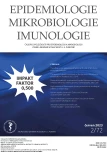Secondary prevention of lung cancer in the Czech Republic – pitfalls, risks, benefits
Authors:
D. Horáková; L. Štěpánek; J. Ševčíková; R. Durďáková; J. Vlčková
Authors‘ workplace:
Ústav veřejného zdravotnictví Lékařské fakulty Univerzity Palackého v Olomouci
Published in:
Epidemiol. Mikrobiol. Imunol. 72, 2023, č. 2, s. 120-123
Category:
Short Communication
Overview
Lung cancer (LC) is one of the most frequently diagnosed cancers and one of the leading causes of cancer deaths in the Czech Republic, the prevalence of which is steadily increasing. There is scientific evidence that LC screening through low-dose computed tomography (LDCT) reduces the risk of death from LC. No systematic LC screening strategy has been currently in place in the Czech Republic. Since the beginning of 2022, the methodology of early detection of LC using LDCT has been piloted to test the feasibility of the screening program. The primary purpose of the project is an early and accurate diagnosis of the disease, which, in combination with follow-up treatment, will lead to a reduction in LC mortality. The pilot data will definitely serve as a basis for an expert discussion of the acceptability of the program to the Czech population and its impact on the healthcare system. It is clear that by introducing such a screening program, we will join the countries that, based on scientific data, enable the population to profit from an actively implemented LC prevention strategy. Public awareness of the benefits of early non-invasive LC detection can contribute to higher compliance of at-risk persons and their willingness to participate in the program. The key role in the entire process is played by general practitioners and/or outpatient pulmologists who address at-risk individuals and can positively influence their involvement in the program.
Keywords:
lung cancer – screening – secondary prevention – low-dose CT
Sources
1. Státní zdravotní ústav. Novotvary 2018 ČR [online]. 2021 [cit. 2022-8-11]. Dostupné na www: <http://www.uzis.cz/index.php?pg=record&id=8352.
2. Göpfertová D, et al. Epidemiologie. Praha: TRITON;1999. 228 s. ISBN 80-7254-037-8.
3. International Agency for Research on Cancer. Global Cancer Observatory: Cancer Today. Lyon, France: International Agency for Research on Cancer [online]. 2018 [cit. 2022-8-11]. Dostupné na www: <https://gco.iarc.fr/today.
4. MZČR. Metodika realizace populačního pilotního programu časného záchytu karcinomu plic. [online] 2020 [cit. 2022-8-11] Dostupné na www: <https://www.mzcr.cz/metodika-realizace-populacniho-pilotniho-programu-casneho-zachytukarcinomu-plic/.
5. Pinsky PF. Principles of Cancer Screening. Surg. Clin. North. Am., 2015;95(5):953–966.
6. Houston T. Screening for Lung Cancer. Med. Clin. North. Am., 2020;104(6):1037–1050.
7. Toumazis I, Bastani M, Han SS, et al. Risk-Based lung cancer screening: A systematic review. Lung Cancer, 2020;147 : 154–186.
8. Yang D, Liu Y, Bai C, et al. Epidemiology of lung cancer and lung cancer screening programs in China and the United States. Cancer Lett., 2020;468 : 82–87.
9. Tringali G, Milanese G, Ledda RE, et al. Lung Cancer Screening: Evidence, Risks, and Opportunities for Implementation. Rofo, 2021;193(10):1153–1161.
10. Hoffman RM, Atallah RP, Struble RD, et al. Lung Cancer Screening with Low-Dose CT: a Meta-Analysis. J. Gen. Intern. Med., 2020;35(10):3015–3025.
11. Eggert JA, Palavanzadeh M, Blanton A. Screening and Early Detection of Lung Cancer. Semin. Oncol. Nurs., 2017;33(2):129–140.
12. Benbassat J. Duration of lead time in screening for lung cancer. BMC Pulm Med, 2021;21(1):4.
13. Gierada DS, Black WC, Chiles C, et al. Low-Dose CT Screening for Lung Cancer: Evidence from 2 Decades of Study. Radiol. Imaging. Cancer, 2020;2(2):e190058.
Labels
Hygiene and epidemiology Medical virology Clinical microbiologyArticle was published in
Epidemiology, Microbiology, Immunology

2023 Issue 2
Most read in this issue
- Selected aspects of mortality in Czechia and Slovakia in the pandemic year 2020
- A word on the microbiome: considerations about the history, current state, and terminology of an emerging discipline
- The influence of meteorological factors on the risk of tick-borne encephalitis infection
- Secondary prevention of lung cancer in the Czech Republic – pitfalls, risks, benefits
